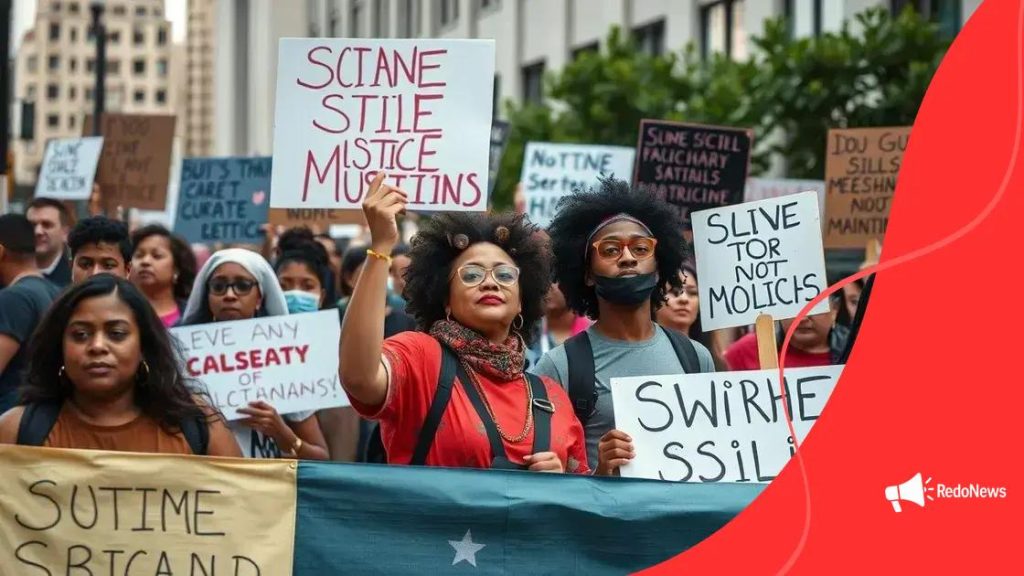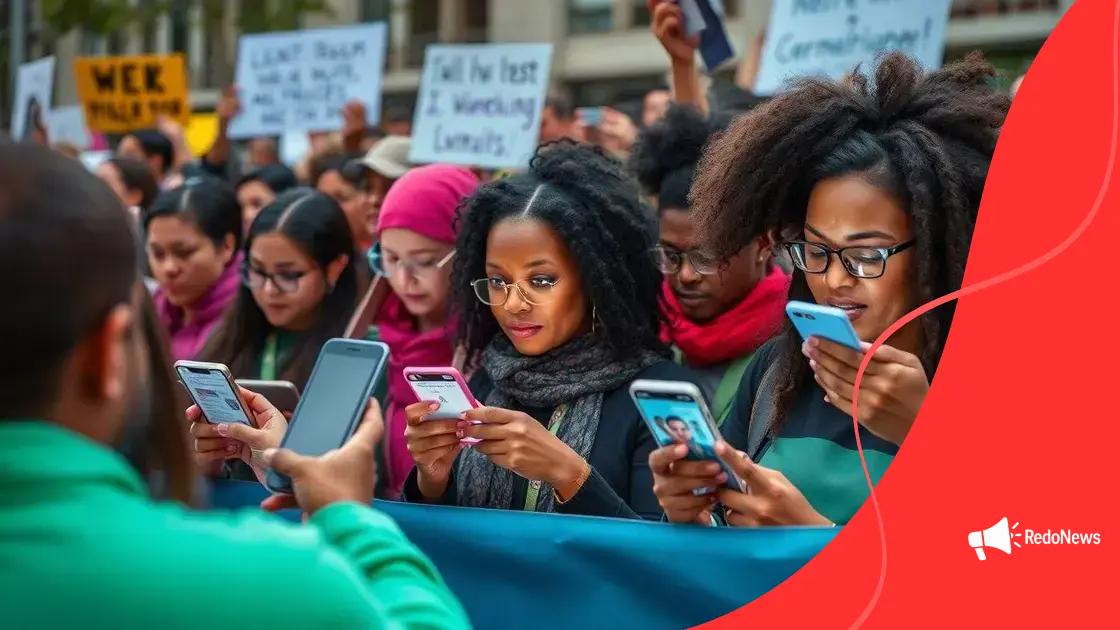Social justice: Activism continues to shape society

Social justice activism is a dynamic movement driven by technology, youth involvement, and a focus on inclusivity, facing challenges such as political opposition and misinformation while striving for meaningful change.
Social justice: Activism continues to be a driving force in advocating for marginalized communities, inspiring change and fostering equality. Have you considered how these efforts shape our world?
Understanding social justice activism
Understanding social justice activism is essential for recognizing its impact on our society. Activism has taken various forms over the years, and today it is more crucial than ever. Through advocacy and community engagement, individuals strive to promote equality and address systemic issues.
The Foundations of Social Justice
At its core, social justice is about ensuring that everyone has equal rights and opportunities. This involves addressing not only individual disparities but also the structures that perpetuate these inequalities. Activists work diligently to challenge these systems and promote fairness.
Key Components of Activism
- Awareness: Raising awareness about critical issues is vital for mobilizing support.
- Engagement: Connecting with communities helps to build a stronger base for change.
- Advocacy: Lobbying for policy changes is often a key goal for activists.
- Solidarity: Supporting one another creates a united front against injustice.
Activism is not limited to protests or rallies; it can also manifest through art, education, and online platforms. For instance, social media has become a powerful tool for activists, enabling them to share their messages widely and connect with like-minded individuals. By leveraging technology, activists can amplify their voices and raise awareness on a global scale.
Furthermore, understanding how history shapes current activism is important. Many movements today are influenced by the struggles of the past, drawing lessons from previous activists. This continuity allows for a richer and more informed approach to tackling modern challenges. For example, the civil rights movement laid the groundwork for today’s social justice initiatives.
As we delve deeper into the realm of social justice activism, it’s vital to recognize the importance of intersectionality—acknowledging how various forms of discrimination overlap. This perspective helps to create more inclusive movements that consider the diverse experiences of all individuals.
The role of youth in social movements
The role of youth in social movements is pivotal and often transformative. Young people bring energy, creativity, and fresh perspectives to activism. They are not just participants; they are leaders driving change.
The Power of Youth Voices
Young activists are using their voices to challenge the status quo. They address issues like climate change, racial inequality, and education reform with passion and urgency. By speaking out, they ensure that important topics are front and center in public discourse.
How Youth Engage in Activism
- Using Social Media: Platforms like Instagram and Twitter allow youth to spread awareness quickly.
- Organizing Events: From protests to community forums, young people create spaces for dialogue.
- Creating Art: Art can communicate powerful messages, inspiring others to take action.
- Building Coalitions: Young activists often collaborate across different movements to amplify their impact.
Moreover, youth involvement fosters a sense of responsibility and ownership. As they engage in social causes, they learn about leadership and teamwork. This experience not only benefits their communities but also empowers them as they grow into adulthood.
Young people also excel at mobilizing their peers. Their ability to connect through shared experiences and values helps to create a sense of community among activists. This camaraderie is essential for sustaining momentum in social movements.
The challenges facing youth activists are significant, as they often encounter skepticism from older generations. However, their innovative approaches often break through barriers. From organizing digital campaigns to harnessing grassroots networks, youth find ways to make their voices heard.
Impact of social media on activism

The impact of social media on activism has changed how movements are organized and how messages are disseminated. With platforms like Twitter, Instagram, and Facebook, activists can reach a wide audience in a matter of seconds. This rapid communication has become a game-changer for social justice efforts worldwide.
Instant Communication
One of the main benefits of social media is instant communication. Activists can share important updates, plan events, and mobilize supporters quickly. This immediacy is crucial during emergencies or when immediate action is needed.
Raising Awareness
- Viral Campaigns: Hashtags like #BlackLivesMatter and #MeToo have helped spread awareness rapidly.
- Visual Storytelling: Images and videos capture attention more effectively than text alone.
- Engagement: Social media encourages discussions and helps people connect over shared causes.
- Global Reach: Activism can extend beyond local borders, engaging individuals worldwide.
Moreover, the ability to share personal stories is a powerful aspect of social media. When individuals recount their experiences related to social issues, it creates empathy and understanding. These stories often motivate others to get involved, creating a ripple effect within communities.
Another notable change is how young people are leading online activism. They are particularly skilled in using digital tools and engaging their peers. By integrating humor, creativity, and relevant cultural references, youth activists can attract more followers and supporters. Their unique approaches often resonate with a younger audience, making important issues feel accessible.
However, social media can also present challenges. Misinformation can spread just as quickly as accurate information, sometimes leading to confusion or backlash. It’s crucial for activists to verify facts before sharing. Additionally, online activism should complement, not replace, traditional activism methods like protests and community organizing.
Challenges faced by activists today
Activists today face several challenges that can hinder their efforts to promote social justice. These obstacles range from political pushback to societal perceptions. Understanding these challenges is crucial for developing effective strategies to overcome them.
Political and Legal Barriers
One significant challenge is political opposition. Many activists encounter resistance from government officials or law enforcement. This can result in legal repercussions for peaceful protests or advocacy. Activists often have to navigate complex laws and regulations that can restrict their activities.
Funding and Resources
- Limited Funding: Securing financial support for initiatives is often difficult, especially for grassroots movements.
- Resource Allocation: Activists must prioritize how to use their limited resources effectively.
- Access to Training: Many activists seek training on best practices but may find it hard to obtain.
- Networking Opportunities: Finding connections with other organizations can sometimes be a challenge.
Additionally, social media can have mixed effects. While it helps spread awareness, it can also lead to misinformation or negative backlash. Activists may find themselves fighting against false narratives that can damage their credibility. Moreover, the pressure of maintaining a strong online presence can be overwhelming, leading to burnout.
Another challenge is public engagement. In an era of information overload, it can be tough to capture people’s attention. Activists need to craft compelling messages that resonate with diverse audiences. This requires creativity and adaptability in their outreach efforts.
The mental health of activists is also an important consideration. Constant exposure to social injustices can lead to compassion fatigue or burnout. Activists must prioritize self-care to sustain their efforts effectively. Balancing personal well-being with activism is a constant struggle.
Future of social justice initiatives
The future of social justice initiatives looks promising yet challenging. As global awareness of social issues continues to grow, there is a greater need for innovative solutions to address injustices. Activists and organizations are exploring new strategies to engage communities and effect meaningful change.
Technology’s Role
Technology plays a crucial part in shaping the future of activism. With the rise of digital tools, movements can organize more effectively and reach wider audiences. Social media platforms will likely continue to be central to these efforts, allowing for rapid information sharing and mobilization.
Focus on Inclusivity
- Diverse Representation: Movements are increasingly prioritizing diversity, ensuring that voices from all backgrounds are heard.
- Intersectional Approaches: Activists are adopting intersectionality to address overlapping issues like race, gender, and economic status.
- Community Engagement: Building strong community ties will become even more important for sustained activism.
- Education and Awareness: Ongoing education about social justice issues will be vital for driving change.
Additionally, the future of social justice will likely see a rise in grassroots movements. Ordinary people are becoming leaders in advocating for their communities. This shift empowers individuals to take initiative in addressing local problems.
Collaboration among organizations is also expected to grow. By forming alliances, different groups can combine resources and expertise. This approach enhances the effectiveness of initiatives and ensures that efforts are not duplicated.
As we look ahead, challenges such as political opposition and resource constraints will remain. Activists will need to adapt and innovate to navigate these hurdles. However, the resilience and creativity shown by young people today give reason to hope for a brighter future in social justice.
In conclusion, the landscape of social justice activism is evolving rapidly. As we see a greater involvement from youth, the use of technology, and increased focus on inclusivity, the path forward is filled with both challenges and opportunities. Activists are striving to adapt to changing circumstances while remaining committed to their causes. Their resilience and creativity are inspiring, showcasing the power of collective action. Together, these efforts are paving the way for a brighter future in social justice.
FAQ – Frequently Asked Questions about Social Justice Activism
What is the role of technology in social justice activism?
Technology helps activists organize, spread awareness, and connect with supporters quickly and efficiently.
How can youth contribute to social movements?
Youth bring fresh ideas, energy, and a strong social media presence, playing a key role in mobilizing their peers.
What challenges do activists face today?
Activists encounter political opposition, funding issues, misinformation, and the need for community engagement.
Why is inclusivity important in social justice initiatives?
Inclusivity ensures that diverse perspectives are represented, making movements more effective and impactful.
